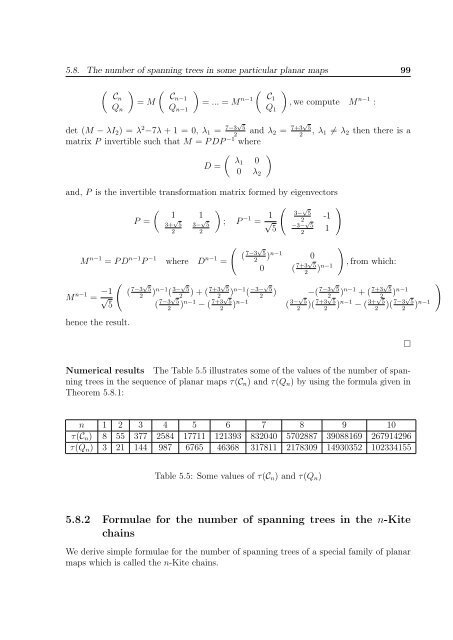enumeration of the number of spanning trees in some ... - Toubkal
enumeration of the number of spanning trees in some ... - Toubkal
enumeration of the number of spanning trees in some ... - Toubkal
You also want an ePaper? Increase the reach of your titles
YUMPU automatically turns print PDFs into web optimized ePapers that Google loves.
5.8. The <strong>number</strong> <strong>of</strong> <strong>spann<strong>in</strong>g</strong> <strong>trees</strong> <strong>in</strong> <strong>some</strong> particular planar maps 99(Cn)= MQ n(Cn−1Q n−1)= ... = M n−1 (C1Q 1), we compute M n−1 :det (M − λI 2 ) = λ 2 −7λ + 1 = 0, λ 1 = 7−3√ 5and λ2 2 = 7+3√ 5, λ2 1 ≠ λ 2 <strong>the</strong>n <strong>the</strong>re is amatrix P <strong>in</strong>vertible such that M = P DP −1 where( )λ1 0D =0 λ 2and, P is <strong>the</strong> <strong>in</strong>vertible transformation matrix formed by eigenvectors( 1 1P =3+ √ 523− √ 52M n−1 = P D n−1 P −1 where D n−1 =(M n−1 = √ −15hence <strong>the</strong> result.)(; P −1 = √ 15(( 7−3√ 53− √ 52-1−3− √ 512)) n−1 02, from which:0 ( 7+3√ 5) n−1 2)( 7−3√ 5) n−1 ( 3−√ 5) + ( 7+3√ 5) n−1 ( −3−√ 5) −( 7−3√ 5) n−1 + ( 7+3√ 5) n−12 2 2 2 2 2( 7−3√ 5) n−1 − ( 7+3√ 5) n−1 ( 3−√ 5)( 7+3√ 5) n−1 − ( 3+√ 5)( 7−3√ 5) n−1 2 2 2 2 2 2)□Numerical results The Table 5.5 illustrates <strong>some</strong> <strong>of</strong> <strong>the</strong> values <strong>of</strong> <strong>the</strong> <strong>number</strong> <strong>of</strong> <strong>spann<strong>in</strong>g</strong><strong>trees</strong> <strong>in</strong> <strong>the</strong> sequence <strong>of</strong> planar maps τ(C n ) and τ(Q n ) by us<strong>in</strong>g <strong>the</strong> formula given <strong>in</strong>Theorem 5.8.1:n 1 2 3 4 5 6 7 8 9 10τ(C n ) 8 55 377 2584 17711 121393 832040 5702887 39088169 267914296τ(Q n ) 3 21 144 987 6765 46368 317811 2178309 14930352 102334155Table 5.5: Some values <strong>of</strong> τ(C n ) and τ(Q n )5.8.2 Formulae for <strong>the</strong> <strong>number</strong> <strong>of</strong> <strong>spann<strong>in</strong>g</strong> <strong>trees</strong> <strong>in</strong> <strong>the</strong> n-Kitecha<strong>in</strong>sWe derive simple formulae for <strong>the</strong> <strong>number</strong> <strong>of</strong> <strong>spann<strong>in</strong>g</strong> <strong>trees</strong> <strong>of</strong> a special family <strong>of</strong> planarmaps which is called <strong>the</strong> n-Kite cha<strong>in</strong>s.

















